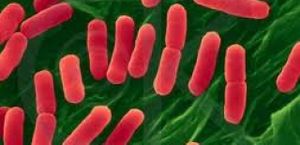Lactobacillus crispatus
Classification
Domain (Bacteria); Phylum (Firmicutes); Class (Bacilli); Order (Lactobacillales); Family (Lactobacillaceae); Genus (Lactobacillus) Species: Lactobacillus crispatus
Description and Significance
As research is done on the human body, it is becoming clear that it is not only itself a living organism, but it is also home to thousands of species of microbes. Surprisingly, most of these microbes are not only benign but are helpful to the body in a variety of capacities. In particular, Lactobacillus crispatus, which is found in the vagina of healthy females, is an integral part of the delicate bacterial fauna that grows there.
In many studies, it has been shown that Lactobacillus crispatus is critical in preserving fertility and preventing vaginal infections such as Bacterial Vaginosis and Vulvo-vaginal Atrophy (VVA) [1] , [2]. These infections can cause irritation and an odorous discharge from the vagina. L. crispatus prevents these infections by preserving the balance of microbe populations and maintaining a low pH. More specifically, it produces lactic acid from sugars, meaning it uses homofermentative metabolism, which aids in the deceleration of cervical epithelial cells. If the population of L. crispatus were depleted, bacterial vaginosis most likely occurs [3].
L. crispatus is also being utilized in the food industry to produce β-galactosidases. Cloned nucleotides from DNA are put in a recombinant plasmid (2 genes). The plasmid is transformed into P. pastoris cells. Two strains from this experiment had high beta-galactosidase activity in the supernatant. The success of this experiment made L. crispatus the first strain to have the gene for β-galactosidases removed and successfully cultivated in a eukaryotic system, creating a much more efficient way of obtaining the protein [4].
Another common use of L. crispatus is in probiotic formulas. These uses ultimately lead to the genome sequencing of the microbe since strain typing must be accurate when using bacteria in food. PCR restriction fragment length polymorphism (PCR-RFLP) analysis, which is a process by which DNA samples are amplified using primers and DNA polymerases, was used to cluster strains into six species. However, no differentiation was on the strain level. Random amplified polymorphic DNA (RAPD) PCR achieved what PCR-RFLP lacked but couldn't reproduce. MLST (multilocus sequence typing) scheme most successfully clustered the individual strains into species. [5]
Genome Structure
Because of its use in the food industry, a complete genome has been obtained for L. Crispatus. It was originally sequenced by T. Ojala in 2010. The Chromosome is circular with a length of 2,043,161 bases or 2.04 Mb. The genome has 37% G+C content with no plasmids and contains 2,022 protein genes. There are also 76 RNA genes present which include 4 rRNA operons, 2 CRISPR loci, and 64 tRNA genes. 13% of the genome is novel and not found in other species [6].
Ecology and Pathogenesis
Lactobacillus crispatus is a rod-shaped, Gram positive facultative anaerobe. The species is obligate homofermentative, meaning it only produces one end product from its metabolism. This is one of the main reasons that L. crispatus is useful to the food industry.
L. crispatus colonies are often found in the GIT (gastro-intestinal tract) of humans and chickens and show growth at 45°C. They cluster at an isolate with proteins that ferment: cellobiose, esculin, galactose, lactose, melibiose, raffinose, starch, and sucrose [7].
References:
1. Brotman, R. M., Shardell, M. D., Gajer, P., Fadrosh, D., Chang, K., Silver, M. I., … Gravitt, P. E. 2013. Association
between the vaginal microbiota, menopause status, and signs of vulvovaginal atrophy. Menopause. 10(1097): 33-39.
Du Toit, M., Dicks, L.M.T, Holzapfel, W.H. 2008. Taxonomy of obligately homofermentative and facultively
heterofermentative Lactobacillus in pig feces.
2. Mitchell, C., Manhart, L. E., Thomas, K., Fiedler, T., Fredricks, D. N., & Marrazzo, J. 2012. Behavioral Predictors of Colonization with Lactobacillus crispatus or Lactobacillus jensenii after Treatment for Bacterial Vaginosis: A Cohort Study. Infectious Diseases in Obstetrics and Gynecology, 10(15): 7-15.
3. Motevaseli, E., Shirzad, M., Raoofian, R., Hasheminasab, S.-M., Hatami, M., Dianatpour, M., & Modarressi, M.-H. 2013. Differences in Vaginal Lactobacilli Composition of Iranian Healthy and Bacterial Vaginosis Infected Women: A Comparative Analysis of Their Cytotoxic Effects with Commercial Vaginal Probiotics. Iranian Red Crescent Medical Journal, 15(3): 199–206.
4. Nie, C., Liu, B., Zhang, Y., Zhao, G., Fan, X., Ning, X., & Zhang, W. 2013. Production and secretion of Lactobacillus crispatus β-galactosidase in Pichia pastoris. Protein expression and purification, 92(1), 88–93.
5. Ojala, T., Kuparinen, V., Koskinen, J. P., Alatalo, E., Holm, L., Auvinen, P., … Kankainen, M. 2010. Genome Sequence of Lactobacillus crispatus ST1. Journal of Bacteriology, 192(13): 3547–3548.
6. Ramachandran, P., Lacher, D. W., Pfeiler, E. A., & Elkins, C. A. 2013. Development of a tiered multilocus sequence typing scheme for members of the Lactobacillus acidophilus complex. Applied and environmental microbiology. 10(28): 7-13.
7. Witkin, S. S., Mendes-Soares, H., Linhares, I. M., Jayaram, A., Ledger, W. J., & Forney, L. J. 2013. Influence of vaginal bacteria and D- and L-lactic acid isomers on vaginal extracellular matrix metalloproteinase inducer: implications for protection against upper genital tract infections. mBio, 4(4): 10-13.

